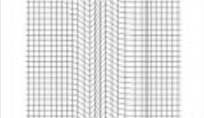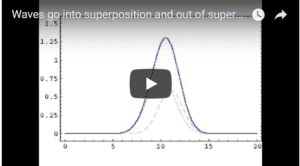Particle, physics definition explained with examples & illustrations & animations (original) (raw)
In everyday speech, a particle is a bit of matter. I might say that there is particle of dirt on the lens of my glasses. Similarly, in classical physics, a particle is a material object that is localized to a specific spot. (Classical physics is the physics of the everyday world of tables and chairs. It is the field of physics which follows Newton’s laws of motion and many other laws developed before those of quantum physics.)
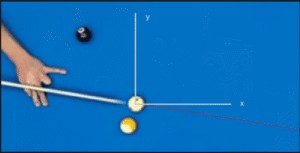
Billiard balls epitomize particles that follow Newton’s Laws of Motion
In classical physics, particles are thought of as being like billiard balls that move in accordance with Newtonian laws of motion. The key properties of a particle are its position, its velocity, its mass, its electric charge (or lack thereof), and a few other properties.
This article is about particles in classical physics, and especially about the difference between classical particles and classical waves. This difference is important to understanding quantum particles, which are addressed in the entry “quantum particles.”
Some of the physical laws which govern particles are obvious to us without studying physics. For example, two particles cannot occupy the same space at the same time. Other laws are not obvious from everyday experience but become quite familiar and understandable upon studying classical physics. For example, particles travel in straight lines at constant velocity unless acted on by a force.
Differences Between a Particle and a Wave
A wave is a patterned movement through a medium. Click to see the animation. [Animation by: Christophe Dang Ngoc Chan (cdang) – Own work, CC BY-SA 3.0; https://en.wikipedia.org/wiki/Seismic_wave. Retrieved March 22, 2018]
In physics, the term “particle” is used in contrast to “wave.” A wave is spread out. Specifically, it is a motion that repeats and, in this way, moves through a medium.
In a wave, a motion of one particle instigates the same motion in a neighboring particle. A wave that travels through the crowd in a football stadium is a good metaphor for a wave in physics. Each person or group stands and inspires their neighbor to stand. The motion ripples through the crowd.
Wave in a stadium crowd, a metaphor for a physical wave. [Animation source: https://en.wikipedia.org/wiki/Wave_(audience). Retrieved Feb. 18, 2018]
The people aren’t moving their bodies down the bench—they each sit down again in exactly the same seat. But something is moving around the stadium—a motion–up and then down. The motion propagates because each person has decided that when my neighbor stands and then starts to sit, I’ll stand up. In contrast, physical waves like a sound wave propagates by molecules of air pushing on neighboring molecules of air, which, in turn push on their neighbors. In this way, the wave travels through the air.
Particles and waves act quite differently. When particles collide, they might bounce off each other. But if they collide with enough force, they explode and create new particles and/or release energy. For example, when playing billiards, two billiard balls will bounce off each other. But, if one were to come at the other with rocket-powered speed, they would explode upon contact.
In contrast, when waves in the same medium encounter each other, they don’t bounce off each other nor do they explode. Rather, they travel through each other. While they are traveling through each other, if they are similar in frequency, they can form a superposition. In a superposition, the effects of one wave adds to the effects of another. One wave piggybacks on the other, creating what appears as a new wave that is the sum of the two.
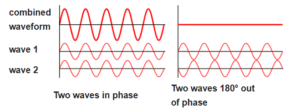
Superposition: (Left) Wave 1 adds to Wave 2, creating a larger amplitude combined waveform. (Right) Wave 1 adds to Wave 2, cancelling and leaving no visible wave. [Image source: By Haade, CC BY-SA 3.0, https://en.wikipedia.org/wiki/Superposition_principle#Wave_superposition, Retrieved March 27, 2018]
The accompanying diagram (right) shows two different kinds of superpositions. On the bottom left, Wave 1 and Wave 2 are in phase. That is, their crests and troughs form at the same moment in time, simultaneously. In the “Combined Waveform,” their sum reinforces each other. They create higher crests and deeper troughs.
Here’s how this type of superposition could form. Let’s say a pebble were thrown into a pond. It would create circles of waves. Let’s say a second pebble were thrown in exactly the same spot and (miraculously) its waves were perfectly in phase with the waves of the first. Then, the combined waves would be double in height compared to the waves of the first pebble.
On the right side of the accompanying diagram is another possible outcome of two waves flowing through each other. Its ripples might be precisely out-of-phase with the ripples of the first pebble. Then, the two sets of ripples would cancel each other. The resulting combined wave would not look like a wave at all. The water would appear flat.
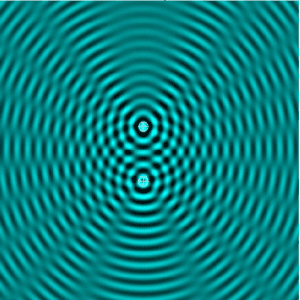
Wave interference pattern (also called “diffraction pattern”). [Image source: Public Domain]
Of course, in reality, the second pebble would not likely fall in exactly the same spot as the first. Nor would its ripples be perfectly in-phase nor perfectly out-of-phase with those of the first. So, the most likely outcome would be partial cancellation of some ripples and partial reinforcement of others. The result would be the familiar criss-crossing pattern of ripples formed when two pebbles are thrown into a pond (see accompanying image). This criss-crossing pattern is the signature sign of a wave. It is called an “interference pattern” or a “diffraction pattern.”
Waves Resume After a Superposition
Waves go into superposition and out of superposition, animated. [Animation by San Diego State University physics program http://sdsu-physics.org/physics180/physics180A/units/unit3/mechanical_waves.html. Retrieved March 28, 2018]
An interesting feature of waves is that they retain their integrity. Should two waves combine in a superposition and then separate, each would emerge and resume its original shape and properties as if nothing had happened. This is shown in the accompanying animation.
Differences in Properties Between Waves and Particles
Waves have many properties not shared by the particles of classical physics. Waves have frequency, period, and wavelength. They experience refraction, diffraction, and as noted above, superposition.
For more information on each of these wave properties and for more on the differences between classical particles and classical waves, see the section “Wave Properties vs. Particle Properties” in the entry for wave.
Footnotes
